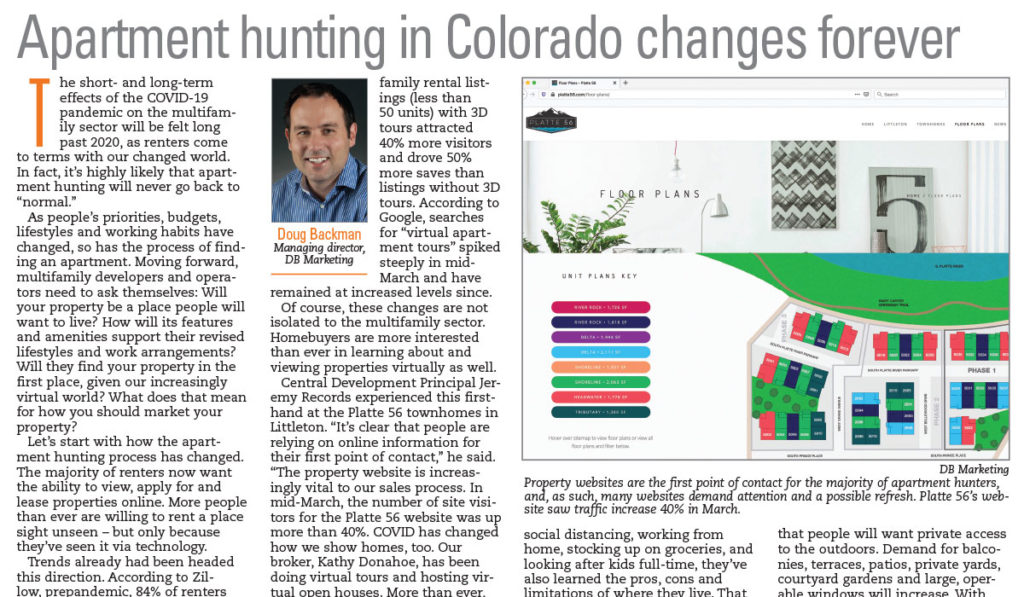
Apartment hunting in Colorado changes forever
Apartment hunting in Colorado changes forever https://www.centraldevelopment.com/wp-content/uploads/Apartment-hunting-in-Colorado-changes-forever-1024x597.jpg 1024 597 Central Development Properties Central Development Properties https://www.centraldevelopment.com/wp-content/uploads/Apartment-hunting-in-Colorado-changes-forever-1024x597.jpgMultifamily Properties Quarterly
The short- and long-term effects of the COVID-19 pandemic on the multifamily sector will be felt long past 2020, as renters come to terms with our changed world. In fact, it’s highly likely that apartment hunting will never go back to “normal.”
As people’s priorities, budgets, lifestyles and working habits have changed, so has the process of finding an apartment. Moving forward, multifamily developers and operators need to ask themselves: Will your property be a place people will want to live? How will its features and amenities support their revised lifestyles and work arrangements? Will they find your property in the first place, given our increasingly virtual world? What does that mean for how you should market your property?
Let’s start with how the apartment hunting process has changed. The majority of renters now want the ability to view, apply for and lease properties online. More people than ever are willing to rent a place sight unseen – but only because they’ve seen it via technology.
Trends already had been headed this direction. According to Zillow, prepandemic, 84% of renters already were using online apartment- hunting resources, and more than half said they’d prefer applying online. Nearly half said they wanted more virtual tours.
COVID-19 accelerated the trend by making virtual visits necessity rather than convenience. When the pandemic hit in March, singlefamily rental listings (less than 50 units) with 3D tours attracted 40% more visitors and drove 50% more saves than listings without 3D tours. According to Google, searches for “virtual apartment tours” spiked steeply in mid- March and have remained at increased levels since.
Of course, these changes are not isolated to the multifamily sector. Homebuyers are more interested than ever in learning about and viewing properties virtually as well.
Central Development Principal Jeremy Records experienced this firsthand at the Platte 56 townhomes in Littleton. “It’s clear that people are relying on online information for their first point of contact,” he said.
“The property website is increasingly vital to our sales process. In mid-March, the number of site visitors for the Platte 56 website was up more than 40%. COVID has changed how we show homes, too. Our broker, Kathy Donahoe, has been doing virtual tours and hosting virtual open houses. More than ever, people want to see a place virtually before they’re willing to visit it in person.”
Also worth considering: People’s changing priorities, and how that may impact what they’re looking for in an apartment. As people have learned the ins and outs of quarantining, sheltering in place, social distancing, working from home, stocking up on groceries, and looking after kids full-time, they’ve also learned the pros, cons and limitations of where they live. That means they’ve better identified the amenities and features they value. Finding those amenities and features is likely to be a focus of their apartment-hunting process.

The New York Times recently interviewed leading local architects about how design is likely to evolve post-pandemic. One highlight was that people will want private access to the outdoors. Demand for balconies, terraces, patios, private yards, courtyard gardens and large, operable windows will increase. With more people than ever working from home (a trend that’s likely to continue), demand for flex space will increase. Demand for adequate storage also will increase, as microfridges and small pantries become less realistic. More people may want dedicated entryways or mudrooms that provide a safe space for disinfecting, removing shoes and accepting packages. More people are likely to ask about enhanced technology (e.g., smart-home capabilities, indoor ventilation improvements).
Property websites have become the first point of contact for the incredible majority of apartment hunters. If your website doesn’t successfully convey your multifamily property’s value proposition and help them to make an emotional connection, they are likely to move on.
MVRK Development Principal Jesse Hamilton always understood the central importance of using websites to help renters and homebuyers make these types of emotional connections. He’s confident that Boise property Ascent East End’s new website has been pivotal in helping MVRK prelease units at the multifamily property, a valueadd acquisition and renovation.
“Most developers use a cookiecutter approach on their project websites,” he said.
“I’m a true believer in having a website that can paint a picture of a lifestyle – of a vision, community, amenities and what it feels like to live there. Everyone has always told me you can’t prelease apartments. They’re wrong. Even during COVID-19, we’ve been successfully preleasing our renovated units two months ahead of when we’re delivering them. We had 14 lease applications in March alone, and the majority of those applications were from people who spent time on the website.”
It’s also worth remembering that people’s finances have been impacted. Many have lost income or even jobs. The economic downturn will cause many to tighten their budgets. This means that renters may be harder to come by in some markets and for certain product types.
Apartment List’s Chief Economist Igor Popov predicts that, while fewer total people will move, moves will spike during recovery. He also believes that affordable housing will be harder to find, luxury multifamily housing will be plentiful and a recession could slow the growth of high-income renters searching for luxury apartment inventory. Against this competitive landscape, making sure that your website sets your property apart will be crucial to getting it found, seen and, ultimately, leased or sold.
The COVID-19 pandemic is making the case for real estate marketing better than I ever have. If multifamily developers and operators want to thrive in our increasingly digital world, they’ll be well-served to take a fresh look at their websites.